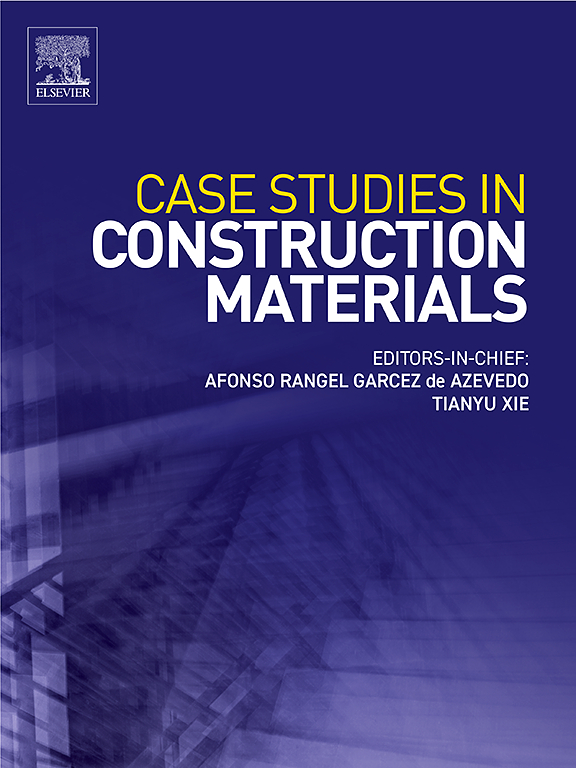Experimental and analytical evaluation of mechanical properties of rubberized concrete incorporating waste tire crumb rubber
IF 6.6
2区 工程技术
Q1 CONSTRUCTION & BUILDING TECHNOLOGY
引用次数: 0
Abstract
This research elucidates the mechanical behavior of rubberized concrete produced with waste tire crumb rubber as a substitute for fine aggregate, a crucial step given the lack of established standards for rubberized concrete design. We scrutinized the tensile strength (fts), flexural strength (ff), and modulus of elasticity (Ec) of rubberized concrete with varying crumb rubber contents, sizes, and pretreatment methods. The mechanisms through which crumb rubber impacts concrete strength were explored, accounting for variances in particle sizes, rubber contents, and pretreatment methods. Over 400 groups of data from existing studies were analyzed to quantify the effect of rubber size, content, and pretreatment on the mechanical properties of rubberized concrete. Results revealed significant variations; notably, as rubber content increased from 0.0 % to 3.0 %, the fts in concrete with crumb rubbers sized 100 mesh, 1–2 mm, and 2–4 mm decreased by 32.2 %, 18.6 %, and 13.2 %, respectively. Conversely, increasing the rubber size from 100 mesh to 1–2 mm and 2–4 mm resulted in notable increases in fts, ff, and Ec. The study further identified that the alterations in concrete's void structure due to crumb rubber inclusion significantly affect its mechanical properties. Our comprehensive analysis led to the development of evaluation equations for fts, ff, and Ec of rubberized concrete, presenting a robust method to predict the mechanical properties of rubberized concrete with varied crumb rubber incorporations. This work bridges a significant gap in the analytical evaluation of rubberized concrete, paving the way for advancing its application in sustainable construction practices.
废轮胎橡胶屑掺合橡胶混凝土力学性能的试验与分析评价
本研究阐明了用废轮胎橡胶屑代替细骨料生产的橡胶混凝土的力学性能,这是由于橡胶混凝土设计缺乏既定标准的关键一步。我们仔细研究了橡胶混凝土的抗拉强度(fts),抗弯强度(ff)和弹性模量(Ec)与不同的橡胶屑含量,大小和预处理方法。通过橡胶屑影响混凝土强度的机制进行了探讨,考虑到颗粒大小、橡胶含量和预处理方法的差异。通过分析现有研究的400多组数据,量化了橡胶粒径、含量和预处理对橡胶混凝土力学性能的影响。结果显示显著差异;值得注意的是,当橡胶含量从0.0 %增加到3.0 %时,粒径为100目、1-2 mm和2-4 mm的橡胶颗粒混凝土的FTS分别下降了32.2% %、18.6% %和13.2 %。相反,将橡胶粒径从100目增加到1-2 mm和2-4 mm会导致ft、ff和Ec显著增加。研究进一步发现,橡胶屑夹杂物对混凝土孔隙结构的改变会显著影响混凝土的力学性能。我们的综合分析导致了橡胶混凝土的fts, ff和Ec的评估方程的发展,提出了一个可靠的方法来预测橡胶颗粒掺入不同的橡胶混凝土的机械性能。这项工作弥合了橡胶混凝土分析评价的重大差距,为推进其在可持续建筑实践中的应用铺平了道路。
本文章由计算机程序翻译,如有差异,请以英文原文为准。
求助全文
约1分钟内获得全文
求助全文
来源期刊

Case Studies in Construction Materials
Multiple-
CiteScore
7.60
自引率
19.40%
发文量
842
审稿时长
63 days
期刊介绍:
Case Studies in Construction Materials provides a forum for the rapid publication of short, structured Case Studies on construction materials. In addition, the journal also publishes related Short Communications, Full length research article and Comprehensive review papers (by invitation).
The journal will provide an essential compendium of case studies for practicing engineers, designers, researchers and other practitioners who are interested in all aspects construction materials. The journal will publish new and novel case studies, but will also provide a forum for the publication of high quality descriptions of classic construction material problems and solutions.
 求助内容:
求助内容: 应助结果提醒方式:
应助结果提醒方式:


